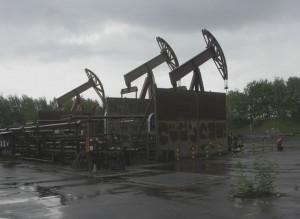 Ever wonder why oil is underground? I don’t mean how it got there (decomposing organisms trapped below layers of sediment that were compressed). I mean why we go through the trouble of digging it out of the ground. I realize it’s energy dense, but hear me out.
Ever wonder why oil is underground? I don’t mean how it got there (decomposing organisms trapped below layers of sediment that were compressed). I mean why we go through the trouble of digging it out of the ground. I realize it’s energy dense, but hear me out.
I find it kind of curious to think about our current energy economy. More than 90% of the energy consumed in this country comes from extracted sources – coal, oil, natural gas, and nuclear. These require lots of resources and cause a fair bit of damage to extract. Just consider mountain top removal (coal), fracking, which has been linked to earthquakes in Ohio (natural gas), and issues associated with ocean contamination (oil spills, including the Exxon Valdez and Deep Water Horizon incidents). That leaves nuclear, which may not be in the news much, but also suffers from environmentally degrading extraction. Obviously there are trade offs when it comes to energy policy. Domestic vs imported energy is a key one right now; just consider our two takes on the debate surrounding the Keystone XL pipeline. One view is of the project as a backward looking, misguided approach, the other sees it as a strategic bridge to the future of energy.
Hundreds of years ago wood was the primary source of energy fueling economic growth. Depletion of forests quickly led to its downfall. However, it was possible to see this coming. Forests around cities were shrinking and not being sustainably harvested. Now our energy supply is underground. Technology allows us to “see” it, but we don’t have a sense of what’s left. We can’t actually go and see for ourselves. This gets to the other part of my point. Strong sustainability is defined by using resources that can replenish themselves and in the strictest sense only those that are overly abundant. We don’t know exactly how much oil or natural gas, nuclear or coal remains, not that it matters, since they are finite. With all of this in mind, it is vital that we move toward an economy that uses the sun and wind, resources that are virtually free and – more to the point – unending. For centuries humankind relied on them. While those societies do not resemble the “advanced” society of today, they far surpassed our extractive energy economy in terms of their long term sustainability.
Now consider this, “Every hour, enough sunlight reaches the Earth to meet human’s energy needs for a year; yet solar energy accounts for just 0.015 percent of world electricity production.” Obviously there are major barriers to converting this energy into a usable form for transportation (among other needs). Consider the examples of photosynthesis and passive solar heating, nature already does the job.
We’ve written about the regenerative economy on several occasions in the past. Relying on the sun (which generates wind and ultimately powers photosynthesis) represents a significant move in that direction. The barriers are immense, but a future bereft of coal, oil, and natural gas – not to mention nuclear fuel – is inevitable. Does it really matter what the time frame is for exhausting those fuel sources?
[Image source: Michael Faherty]

